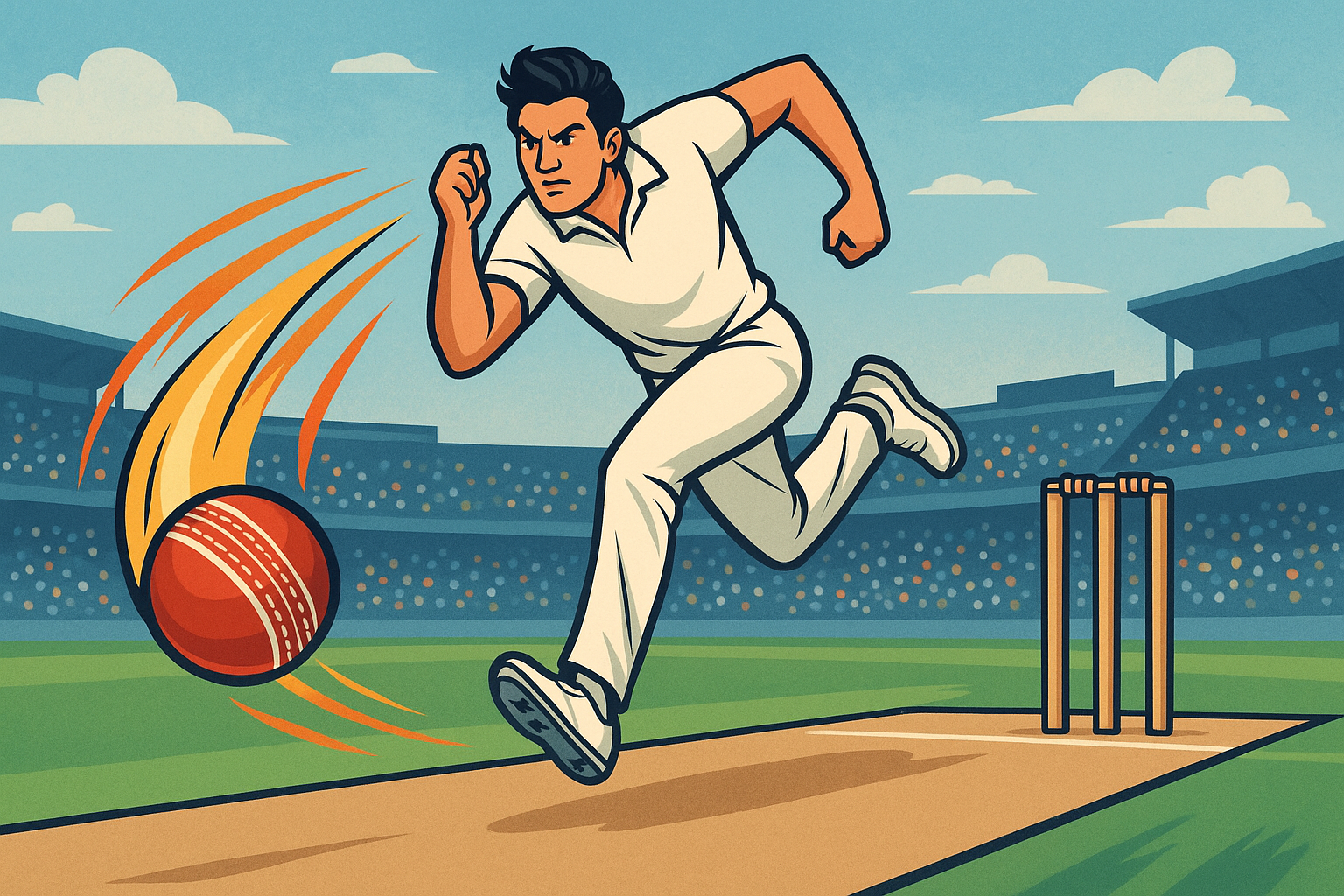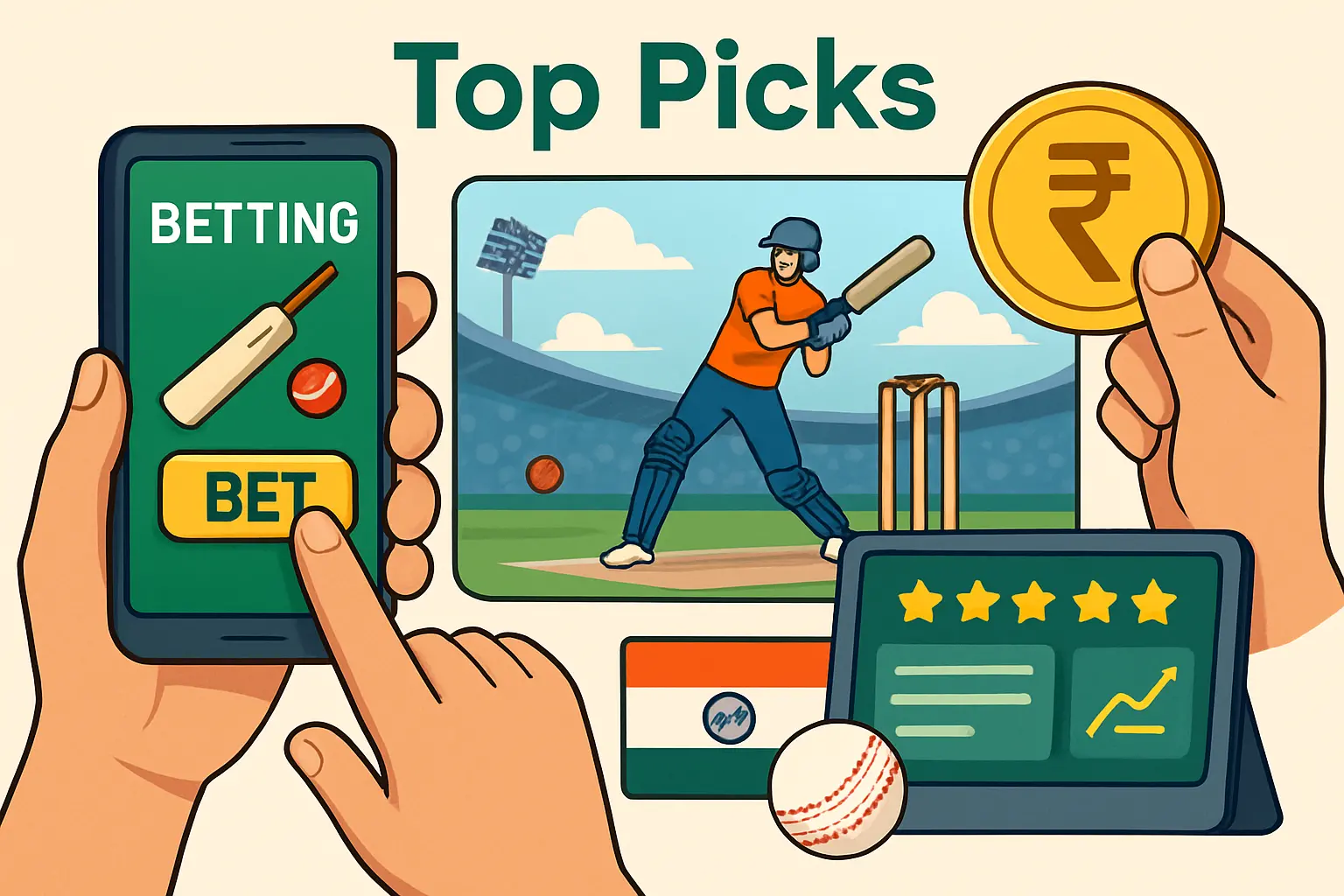The thud of leather on willow, the roar of a delirious crowd, and the split-second instincts of a batsman — these are the enduring images of cricket. But nothing seizes attention, nothing electrifies a stadium quite like the raw, terrifying spectacle of a fast bowler at full tilt. In cricket, fast bowling isn’t just an act of athleticism; it’s an art form, a science, and occasionally, an act of controlled mayhem. Every generation, a handful of men have chased the ultimate question: “Who is the world fastest bowler?” This is not a story measured in mere statistics or speed-gun readings. It is a visceral journey through shattered stumps, bruised egos, and the unending quest to redefine human limits.
The Thrill and Mystic of Extreme Pace
Fast bowling is cricket’s great leveller — and its great intimidator. To stand at the non-striker’s end and watch a speedster tear in, raising dust as he hits the crease, is to glimpse the elemental side of cricket. Batsmen talk of facing express pace as a primal experience: flashes, not frames, where reaction precedes understanding. Spectators feel the threat, the anticipation, the pulse-raising thrill that something dramatic is about to happen.
But what draws bowlers into this rarefied club of fast men? Why risk shattered fingers, ruined shoulders, and the unending, brutal training cycles? For many, it begins with a dream — to answer the taunt that echoes down corridors and on to the school playground: “How fast can you bowl?”
The Science Behind World Fastest Bowler: How Speed is Created
Fast bowling has, over the years, morphed from raw, instinctive athleticism to a carefully engineered craft. But the essence remains unchanged: generate as much speed as the human arm and body allow.
The Anatomy of a Fast Bowler
True pace is summoned through a combination of:
- Explosive run-up: Not a sprint but a controlled acceleration, maximizing momentum without losing balance.
- Seamless kinetic chain: Power generated from the ground up — ankles, knees, hips, torso, shoulder, elbow, wrist — unleashed in a whip-like release.
- Ideal wrist snap: A late and controlled flick imparts that extra burst, sometimes the difference between being quick and world fastest bowler.
- Lightning reflexes and anticipation: Fast bowlers read batsmen as much as batsmen try to pick up length, reacting and adapting on the fly.
Modern biomechanics have allowed coaches and scientists to break down a bowler’s action frame by frame, searching for inefficiencies and micro-optimizations. Still, some things remain unteachable: the raw, genetic cocktail — shoulder flexibility, tendon strength, fast-twitch muscle efficiency — that marks out the rarest, fastest bowlers in cricket history.
The Quest for the World Record Fastest Bowling Speed
For over a century, tales have abounded of tearaway pacemen: thunderbolts whizzing past startled batsmen, umpires ducking for cover. Yet only in more recent years has technology permitted an objective, measured record of the fastest ball ever bowled.
Speed guns, first introduced for broadcast spectacle, became the judge and jury of legend. But the debate still rages — do these electronic eyes capture the precise moment of release, or is there still room for folklore and controversy? Let’s look closer.
Measured Lightning: The Fastest Ball Ever Bowled
To wear the unofficial crown of ‘world fastest bowler’, one must outgun every peer across continents and generations. Of all those who’ve spent a lifetime scaring batsmen, a handful have achieved a level of velocity beyond the imagination.
Shoaib Akhtar: The Rawalpindi Express
The headline that echoes eternally: Shoaib Akhtar fastest delivery. No modern discussion is complete without Pakistan’s Shoaib Akhtar. His action – all arms pumping, hair streaming, chest fully forward – felt more like a slingshot than a bowling arm. He broke the all-time speed record, with a delivery clocked at 161.3 km/h. Eyewitnesses remember the batsman’s stunned reaction, the crowd’s collective gasp, and a speed gun reading that blinked in defiance of all prior logic.
But Akhtar was not just a momentary meteor. He combined fearsome pace with the rare ability to swing the ball both ways, using extreme speed as a tactical weapon, not a mere party trick.
Other Legends Who Pushed the Limits
- Brett Lee (Australia): A master of sustained aggression — his action was the archetype of smooth, biomechanically near-perfect pace bowling. His fastest delivery: 161.1 km/h.
- Shaun Tait (Australia): ‘The Wild Thing,’ with a slingy action and occasional wildness in direction, but devastating on his day. Top speed: 161.1 km/h.
- Jeff Thomson (Australia): In an era bereft of speed guns, old recordings and contemporary testimony still rank his deliveries as some of the quickest ever.
- Mitchell Starc (Australia): Generation-defining left-armer, the spearhead of modern Australian pace. Fastest clocked at 160.4 km/h.
- Andy Roberts, Fidel Edwards (West Indies), Wahab Riaz, Anrich Nortje: All have delivered thunderbolts in excess of 150 km/h, redefining the upper limits in their eras.
Top 10 Fastest Bowlers in the World: The Hall of Speed
Fast bowling, like few other crafts in sport, is relentlessly scrutinized by numbers. But while the debate for ‘who is the fastest bowler in cricket history’ will never truly be settled, these names, defined by official recorded speeds, dominate every discussion:
| Rank | Bowler | Country | Fastest Delivery (km/h) | Notable Format |
|---|---|---|---|---|
| 1 | Shoaib Akhtar | Pakistan | 161.3 | ODI |
| 2 | Shaun Tait | Australia | 161.1 | ODI |
| 3 | Brett Lee | Australia | 161.1 | ODI/Test |
| 4 | Jeff Thomson | Australia | 160.6 (estimated) | Test |
| 5 | Mitchell Starc | Australia | 160.4 | Test |
| 6 | Andy Roberts | West Indies | 159.5 | Test |
| 7 | Fidel Edwards | West Indies | 157.7 | ODI/Test |
| 8 | Anrich Nortje | South Africa | 156.2 | IPL/T20 |
| 9 | Wahab Riaz | Pakistan | 154.5 | ODI |
| 10 | Jasprit Bumrah | India | 153.2 | Test/ODI/T20 |
Note: Data on historical bowlers before electronic speed tracking remains partly anecdotal.
Breaking it Down: Fastest Bowlers by Era and Format
Over decades, cricket’s rules, pitches, equipment, and fitness standards have all shifted. To truly appreciate the world fastest bowler in each context, it’s worth dissecting by era and format, revealing both continuity and evolution.
Fastest Bowlers by Era: Legends Who Ruled Decades
Pre-Electronic Era
- Harold Larwood (England): The architect of ‘Bodyline’ — regarded as fearsome in his time, left batsmen ducking for their lives.
- Wes Hall, Charlie Griffith (West Indies): The Caribbean detonators, laying the foundation for a fast-bowling dynasty.
- Dennis Lillee, Jeff Thomson (Australia): The duo that transformed Ashes cricket into a battle of intimidation.
Technological Era
- Shoaib Akhtar, Brett Lee, Shaun Tait: Raised the bar in the modern age, pushing limits both physical and psychological.
- Mitchell Starc, Anrich Nortje: Prove that raw speed can still survive, even flourish, amidst T20’s tactical variations.
Fastest Bowlers by Country: Speed Across Borders
Pakistan: A Factory of Tearaways
Pakistan’s fast bowling tradition is cult-like — legends are made on sun-baked streets, bowling at abandoned tire marks. Alongside Shoaib Akhtar, Waqar Younis and Mohammad Sami regularly breached 150 km/h; Wasim Akram paired swing artistry with searing pace. The legacy ends with Shaheen Afridi and Haris Rauf.
Australia: Relentless Pace Excellence
The Australian system, built on hard wickets and aggressive cricket ethos, has churned out a surreal list: Brett Lee, Shaun Tait, Jeff Thomson, Dennis Lillee, Mitchell Johnson, Pat Cummins, and Mitchell Starc. No country has more names on ‘Top 10 fastest bowlers in the world’ lists.
West Indies: Fire in Babylon
Their speed revolution rewrote world cricket — from the terrifying Andy Roberts and Michael Holding, through to Malcolm Marshall, Joel Garner, and later, the raw pace of Fidel Edwards.
South Africa & Others
Allan Donald, known as ‘White Lightning,’ symbolized South African resurgence, with successors Dale Steyn and Anrich Nortje continuing the tradition. In India, progress was achieved more gradually — yet bowlers like Javagal Srinath, Umesh Yadav, and Jasprit Bumrah now routinely operate in the high-140s and above.
Comparing Fastest Bowlers By Format
| Format | Record Holder | Speed (km/h) | Competition |
|---|---|---|---|
| Test Cricket | Shoaib Akhtar | 161.0 | England |
| ODI Cricket | Shoaib Akhtar | 161.3 | England |
| T20I | Anrich Nortje | 156.2 | IPL |
| IPL | Anrich Nortje | 156.2 | IPL |
The Art and Science of Fast Bowling
What Separates the World Fastest Bowler from the Merely Quick?
A fast bowler at the very top is more than a speed gun number. It’s about mindset, resilience, and an ability to deliver pace under extreme physical duress. Speed alone won’t earn you 20 wickets in a Test match — but without it, the intimidation factor is diminished.
Tactics matter. Shoaib Akhtar’s bouncers weren’t just throat-searing, but tactically timed. Brett Lee, at his best, paired 160 km/h with late swing. Mitchell Starc’s left-arm angle and vicious inswing make him doubly deadly.
Key Elements for Extreme Pace:
- Body Mechanics: Small technical flaws at high velocity amplify into injuries or loss of control. Elite fast bowlers are coached to fine-tune every element.
- Mental Ferocity: True pace requires unrelenting aggression, the mental stomach to keep returning for one more victim, one more spell.
- Conditioning and Recovery: Fast bowling is physically destructive; only the fittest last. Behind every five-wicket haul lie recovery routines, ice baths, and relentless training.
Innovation and Technique: From Swing to Reverse Swing
The world fastest bowlers have often been innovators, too. Pakistan’s greats pioneered reverse swing at speed, upending batting orthodoxy. Australians explored angles, bouncers, and the wobble seam in white-ball cricket. In India, the art is often about sustaining speed over relentless spells in unforgiving conditions.
Evolution: Has the Speed Ceiling Been Reached?
There’s a question that burns in the minds of fans and scientists: Can anyone bowl faster than Shoaib Akhtar? Are we close to a physical boundary for human speed, or is there room for another generational phenom to emerge?
Athletic Progress, Training, and the Modern Game
Modern bowlers benefit from biomechanics laboratories, video analysis, data-driven fitness plans, and dieticians. Today’s fast bowlers are stronger, more resilient, and (in white-ball cricket, at least) required to bowl at full tilt for shorter periods, which keeps the average pace high.
But there is a trade-off — the toll on bones, the increased scrutiny by medical teams, and the unrelenting international schedule. Coaches often rein in young tearaways, fearing burnout.
T20 and the Fast Bowling Paradox
T20 cricket has changed incentives. Bowlers now prioritize variations, teams often look for control over raw pace, and shortest-format cricket is less forgiving when a bowler is wayward. Yet, ironically, we are seeing more bowlers routinely clock 150 km/h — not out of necessity, but because teams actively scout for and develop these rare talents, especially for ‘powerplay’ and ‘death’ overs.
Behind the Scenes: Life as the World Fastest Bowler
Ask any bowler who has flirted with the world record fastest bowling speed. The reward is fleeting; the pain lingers.
- Shoulders and backs deteriorate early
- Knees ache with every landing
- Fingers become calloused and swollen
- Mental battles become daily routine: Is it worth the risk, the rehab, the lonely gym sessions?
Yet the adrenaline surge — the sight of a batsman late on a 155 km/h bouncer — is intoxicating. Fast bowlers feed off fear, off aura. Even when age takes miles off the speedometer, the memories of ‘that spell’ or ‘that bouncer’ never fade.
Famous On-Field Duels and Moments: The Power of Speed
Cricketing folklore is built on contests where pace was the central protagonist.
- World Cup Showdowns: Shoaib Akhtar’s spellbinding opening bursts.
- Ashes Duels: Jeff Thomson and Dennis Lillee reducing England’s top-order to nervous wrecks.
- IPL Dramas: Anrich Nortje and Umran Malik making commentators gasp with every speed-gun reading.
- South Africa vs. Australia: Shaun Tait vs. AB de Villiers, a real-time test of human reflexes.
Batsmen remember not just being beaten for pace, but being made to feel helpless, as if time itself shrank around them.
Young Fastest Bowlers in Cricket: The New Breed
Tales of new prodigies are gaining ground — bowlers like Lockie Ferguson (New Zealand), Naseem Shah (Pakistan), Umran Malik (India), and Gerald Coetzee (South Africa) routinely clock well above 150 km/h. Each generation, faster and fitter, chases the ultimate rush.
With scientific coaching, bio-mechanical labs, and global T20 exposure, it’s inevitable that the average pace across international cricket is inching higher.
Current Fastest Bowler in the World
The title shifts with every series. In recent seasons, names like Anrich Nortje, Jofra Archer, and Mark Wood are at the top of the leaderboard. In India, Umran Malik turned heads with back-to-back 150+ spells, signaling a new era on traditionally spin-friendly turf.
Frequently Asked Questions: Fast Bowling Demystified
Who Bowled the Fastest Ball in Cricket?
Shoaib Akhtar holds the official record: 161.3 km/h.
How Fast Can a Cricket Ball Be Bowled?
Speeds consistently above 150 km/h are elite; above 155 km/h is exceptional. Theoretical upper limits hover around 165 km/h, though biomechanical strain and safety protocols may keep the record in check.
Who Are the Top 10 Fastest Bowlers in History?
See the detailed list above. The ranks are fiercely contested, but Shoaib Akhtar, Shaun Tait, Brett Lee, and Jeff Thomson top nearly every list.
What is the Average Speed of a Fast Bowler?
At elite level, 140-145 km/h is now standard for most Test/ODI quicks, with the fastest regularly exceeding 150 km/h.
The Unforgiving Race: Fast Bowling’s Future
Where does the future lead? If anything, the world fastest bowler remains cricket’s ultimate enigma, part legend, part science, part spectacle. Records are made to be broken, but the quest itself is imbued with human fallibility. Every generation finds a handful ready to chase down the myth, risking body and reputation for a moment of immortality.
The fast bowler’s life will always be a pendulum: speed and pain, glory and obscurity, respect and fear. Raw pace, at its best, is cricket’s version of controlled chaos — unpredictable, unforgettable, and always capable of blowing away even the greatest.
Conclusion: Pace is the Pulse of Cricket
The chase for the title of world fastest bowler — it’s a journey of pain, ambition, and obsession. These are the men who sacrificed longevity for legend, who defined eras and inspired generations with the simple act of hurling a cricket ball at unthinkable velocity.
Records are numbers, but the impact is primal. From the heart-stopping spells of Shoaib Akhtar, Brett Lee’s relentless hostility, Jeff Thomson’s untamed fury, to the new names rising on the global stage, the spirit of fast bowling remains undimmed.
Cricket needs its fastest — not merely for entertainment, but as a relentless reminder of what happens when speed meets artistry. As new bowlers rise, the legend endures: somewhere, in a net, a young quick is dreaming. The stopwatch is ticking. Who will become the next world fastest bowler?

Zahir, the prolific author behind the cricket match predictions blog on our article site, is a seasoned cricket enthusiast and a seasoned sports analyst with an unwavering passion for the game. With a deep understanding of cricketing statistics, player dynamics, and match strategies, Zahir has honed his expertise over years of following the sport closely.
His insightful articles are not only a testament to his knowledge but also a valuable resource for cricket fans and bettors seeking informed predictions and analysis. Zahir’s commitment to delivering accurate forecasts and engaging content makes him an indispensable contributor to our platform, keeping readers well informed and entertained throughout the cricketing season.



